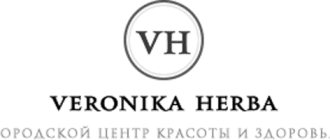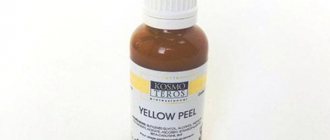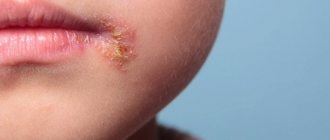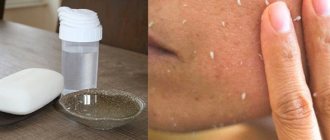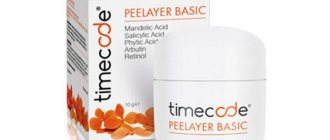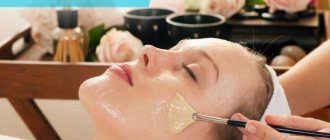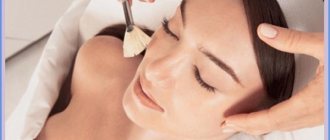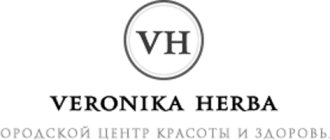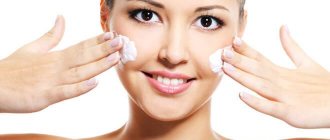From this article you will learn:
- Yellow peeling – what is it?
- Properties of yellow peeling
- How does yellow facial peel work?
- Types of yellow peeling
- What is yellow peeling with salicylic acid
- Who is suitable for yellow skin peeling?
- Contraindications to the yellow peeling procedure
- How is yellow peeling performed in the salon?
- Useful tips for those planning to undergo a course of yellow chemical peeling
- What is the correct care after the yellow peeling procedure?
- How much does yellow peeling cost?
- Is it possible to do yellow peeling at home?
Yellow peeling... This is exactly the “colored” name for retinoic peeling, which is familiar to many. It perfectly helps in the fight against age-related skin changes. During the procedure, the top layer of dead cells is exfoliated, thereby stimulating the regeneration process of the dermis.
Like any other chemical peeling, yellow peeling must be carried out under the supervision of a cosmetologist, who will not only perform the procedure correctly, but also give detailed recommendations for further care. But you will learn in our article what results can be achieved using this amazing technique.
Yellow peeling – what is it?
Among ordinary people, this procedure is better known as yellow peeling rather than retinoic peeling, due to the color of the film that forms on the face during the process. Another unofficial name for the manipulation is “weekend exfoliation,” since after the service is provided, the skin heals very quickly, literally in a couple of days. Therefore, many women make an appointment with a cosmetologist on Friday in order to come to work after the weekend with a fresh and well-groomed face without any consequences of cleansing.
Experts divide cleaning according to the degree of penetration into the skin into superficial, middle and deep, and according to the degree of impact on the dermis - into mechanical and chemical. If we talk about yellow peeling, it has a chemical effect at the surface or middle level.
Recommended articles on the topic:
- Ultrasonic facial peeling is a pleasant and beneficial procedure for your skin
- Redermalization of the skin: all the pros and cons
- Almond peeling for the face: features of the procedure
The mask contains retinol, or retinoic acid. This drug has beneficial properties that have a positive effect on the condition of the skin. It triggers intracellular processes, while gently influencing the dermis of the face.
Let's say a few words about the properties of retinoic acid.
It is close in structure and properties to vinegar. However, when in contact with facial skin, retinoic acid has a milder effect and helps exfoliate dead cells.
Properties of yellow peeling
Beneficial features:
- Stimulation and rejuvenation of the skin.
Retinoic yellow peeling helps improve metabolism in the dermis, stabilizes cell membranes, accelerates their regeneration, protects against harmful radicals, and forms new protein structures such as collagen and elastin.
- Improving the protective properties of the skin.
Such cleaning helps to improve and restore the natural immunity of the dermis, with the help of which it can protect itself from pathogenic microbes. Also, strong immunity promotes rapid healing of wounds.
- Restoration of epithelial tissues in a number of skin diseases.
Retinoic acid helps get rid of acne, acne, loss of pigment at wound sites, and rapid skin regeneration after burns. It helps with psoriasis and dermatitis.
- Lightening facial skin.
Retinoic yellow peeling produces a brightening effect on the skin. The components it contains block the activity of the enzyme tyrosinase, which promotes the release of melanin. Due to the increased activity of the latter, freckles, post-acne and hyperpigmentation appear on the face.
- Prevention of cancer.
There is an opinion among experts that retinoic acid, through its action, can destroy damaged and weak skin cells, preventing the formation of harmful tumors in them, which could lead to the formation of a benign or malignant tumor.
What should be the care after retinoic yellow peeling?
The most important thing for the skin after any chemical procedure is to recover quickly and without consequences. The post-peeling period is a serious time that requires a more careful attitude towards the face and the fulfillment of certain requirements. For the first two weeks, you should not use cosmetics containing retinoids. It is also best to avoid any other treatments, chemical or cosmetic, such as hair coloring or perming.
You can take care of the skin when swelling, various irritations or painful symptoms appear with the help of anti-inflammatory and regenerating drugs, such as a special balm consisting of borage and shea butters, copper peptides, panthenol, fireweed extract, licorice and horse chestnut. This remedy has a calming effect. As a result, the skin quickly returns to its normal state. A special balm is recommended to be used together with aerosols, the basis of which is deuterium (heavy) water, which has strong antibacterial and protective properties.
Two days after peeling, you can start using your usual cleansers. Only they should not contain harsh surfactants, and their base should consist of either water or gel, that is, be fat-free.
Three to four days after the retinoic yellow peeling procedure, characteristic peeling appears on the face. In order for the epidermis to quickly get rid of unnecessary layers, cosmetologists advise applying a mask rich in lactic acid and cranberry enzymes. It has antioxidant, antihistamine and antiviral properties, thanks to which flaky skin returns to its normal state much faster.
How does yellow facial peel work?
Cosmetic manipulation renews the skin and improves the condition of your skin. However, its effect is completely different from other types of exfoliation, which tend to act on the skin from the outside, while the yellow peel solves problems by dealing with them from the inside. Let's take a closer look at this process.
To better understand the differences, let’s compare the effects of retinoic and fruit acids, namely glycolic acid. The latter grossly disrupts the outer layer of the skin, damaging it and removing dead cells, which are subsequently replaced with new ones. Retinoic acid has a milder effect on the dermis of the face, working not with cells directly, but with intercellular structures.
Retinoids do not interact with the top layer of the skin, but with the basal layer, where cells are born. Due to their structure, microparticles of the medicinal substance quickly penetrate to their destination and promote accelerated division and formation of new cells. They begin to actively move towards the surface of the skin and take the place of dead specimens, pushing them out. As a result, the dermis is exfoliated and renewed.
Thus, this composition does not act aggressively on the skin of the face, destroying old cells. On the contrary, it works from the inside and helps the emergence of new healthy specimens. Retinoic acid also helps improve the density and elasticity of your facial skin and its uniform pigmentation.
In addition to this substance, the medicinal composition also contains other components that have a positive effect on the condition of the dermis, such as:
- Phytic, kojic, azeloic acids, which help whiten the skin.
- Salicylic acid – exfoliates dead cells.
- Vitamin C fights free radicals.
- Allantoin, aloe and chamomile extracts produce a calming effect.
Here are some benefits of a cosmetic service:
- has a gentle effect on the skin, there is virtually no discomfort or burning during the procedure;
- after the first session you will be able to see a significant improvement in the condition of your dermis;
- no side effects, skin healing occurs one to two days after the procedure;
- four to five sessions will be enough to consolidate the result;
- the effect lasts for three to four months.
Types of yellow peeling
Yellow peeling comes in two types. Cleanings differ in the amount of retinoic acid used and the time of the procedure.
Cosmetic brands offer exfoliating formulations with varying concentrations of retinoic acid. Thus, the professional product contains approximately 5–10% of this substance, as well as other auxiliary components: kojic, azeloic, phytic and other acids, which produce an additional effect, help whiten the skin, and soothe it.
The first composition contains synthetic retinoic acid, which is a high concentration of retinol. With this active substance content, the product has a deeper effect on the skin of the face. The medicinal composition is applied to the dermis twice with a break of one day. After completing the procedure, it is advisable to avoid direct sunlight, so it is recommended to do it in autumn or winter in mostly cloudy weather. Before the session, you need to prepare your facial skin.
The second composition contains natural retinoic acid, which has a more gentle effect on facial skin. Yellow cream peeling on a natural basis produces superficial cleansing of the dermis. The procedure is performed once every month, interrupted during the summer.
What is the effect of medium retinoic yellow peeling?
Retinoic acid, which may be called tretinoin, is the active form of retinol (or vitamin A). Found naturally in plant foods and animal sources. It is able to form bonds with nuclear receptors, with the help of which it triggers a cellular response. It is important to know that almost all cells in the body are sensitive to retinoic acid. To prevent the accumulation of tretinoin in tissues, as this causes side effects, use a mask with a high content of this substance. It needs to be applied once every couple of weeks. As a result, the epidermis will be renewed at the cellular level. Externally, this will be expressed in characteristic peeling of the skin.
Cosmetologists conducted studies that revealed the following pattern: five yellow peeling procedures done every one week are equal in the results achieved to using the cream for six months. It has also been proven that the chance of any adverse symptoms occurring is extremely small. During peeling, retinoids do not harm the skin, do not destroy living cells and do not lead to protein coagulation.
As a result of the influence of active substances on the skin, the following processes occur:
- The level of mitotic activity in basal keratinocytes increases;
- The processes of keratinization, differentiation and melanogenesis are normalized;
- The number of atypical cells is reduced;
- The processes of synthesis of epidermal lipids, as well as components of the intercellular matrix of the dermis, are activated and stimulated.
All this leads to a slowdown in aging and rejuvenation of the skin, its texture and relief are improved, and an antioxidant effect is achieved.
Let us recall the main advantages of retina yellow peeling: the process is absolutely safe, the occurrence of adverse reactions is minimized, the rehabilitation period takes a minimum amount of time, and the effect lasts for four months after the last session.
Yellow peeling with salicylic acid
If you want to achieve greater results and have a few days to complete a full facial skin treatment, the yellow peeling procedure with salicylic acid is suitable for you. Before applying yellow peeling, the cosmetologist treats the dermis with salicylic acid and then applies the main composition. This manipulation promotes active peeling of dead skin cells.
Salicylic acid actively helps remove dead skin cells from the surface of the face, resulting in a more effective effect of the main composition on problem areas. If your dermis is acne-prone, you should regularly cleanse with this substance. Therapeutic components help heal inflammation and get rid of acne, improve blood circulation and cell restoration process.
We recommend
Laser aesthetic cosmetology: perfect technique for perfect appearance More details
During the procedure, you may feel a slight burning sensation due to the active effect of salicylic and retinoic acids on problem areas of your skin.
After the first session you will notice an improvement in the condition of the dermis. However, do not forget that in order to consolidate the effect, you must undergo a course of treatment. As a result of proper therapy, you will become the owner of smooth, renewed skin. This manipulation will help you:
- Smooth out superficial wrinkles and reduce deep ones.
- Lighten or completely get rid of age spots.
- Even out skin texture and tone.
- Firm and tighten the dermis of the face.
After completing the procedure and removing the composition, you may notice redness of the skin, which is a natural reaction of the body. It will soon pass. However, a couple of days after your yellow salicylic acid peel session, a process will begin in which the top layer of your face's dermis will begin to crack and peel off.
Don’t be alarmed – this is how dead skin cells are removed from the surface so that their place can be taken by renewed and healthy cells. Of course, your appearance may raise many questions and not the most pleasant attention from colleagues and acquaintances. The use of concealing cosmetics will not help you much, and their use is not recommended, as it can limit the access of oxygen to new skin cells. Therefore, it is better to do yellow peeling at a time when you have a few free days to spend in peace at home.
As you know, salicylic acid dries the skin, so this manipulation is not recommended for people with dry skin. If you have thin and sensitive skin, the procedure may be harmful. Yellow peeling with acid is indicated for those with oily and combination skin types.
To consolidate the result, a course of three procedures should be carried out every two weeks. Next, you need to perform prophylaxis every three months.
Who is suitable for yellow skin peeling?
Retinoic yellow peeling is an almost universal cosmetic procedure that allows you to cope with many skin imperfections.
In addition to the usual set that any other exfoliation has, namely getting rid of dullness, greasiness and uneven surface of the dermis, yellow peeling will help you in the fight against:
- wrinkles;
- age spots;
- photoaging;
- decreased turgor;
- thickening of the stratum corneum.
As a rule, most often this cosmetic procedure is performed by women after 40 years of age with the appearance of age-related changes on the face. If you have acne or acne marks, you are also recommended to use this service.
Thanks to its medicinal composition, yellow peeling improves skin condition and helps:
- deeply cleanse the dermis, while producing an antibacterial effect that prevents the development of acne;
- stimulate the production of collagen and elastin, tighten facial contours and smooth out wrinkles;
- even out skin color, making it healthy and matte;
- lighten freckles, age spots and post-acne.
This cosmetic service is recommended for you if you:
- withered dermis, there are wrinkles;
- the sebaceous glands are too active;
- dry skin type;
- there are defects on the face (pits, scars, etc.);
- there are pimples, comedones, blackheads;
- unhealthy complexion.
As you can see, yellow peeling helps fight many skin diseases, so it can be performed by anyone who in one way or another wants to improve the condition of their skin.
Retinoic yellow peeling: indications and contraindications
Indications
for the use of retinoic yellow peeling:
- The appearance of small wrinkles;
- Heavy pigmentation caused by long exposure to the sun;
- Loss of elasticity and firmness;
- Insufficient collagen production;
- Acne;
- Skin aging;
- Insufficient skin hydration;
- Hyperkeratosis;
- Need for bleaching;
- Hyperpigmentation.
The retino yellow peel also has several other benefits. It has a lifting effect, gives the skin a smoother appearance and improves relief, removes any impurities from the surface, and stimulates anti-inflammatory processes. The external condition of the skin improves and a healthy glow appears.
Contraindications
for the use of retinoic yellow peeling:
- Allergic reactions that may be caused by the use of retinol;
- Incompatibility with other medications: this peeling can only be done six months after taking Roaccutane.
- The presence of viral infections, which, together with retinoids, can cause a herpes rash;
- Liver disease, as well as previous hepatitis;
- Increased skin sensitivity, which may be indicated by problems such as atopic skin reactions, seborrheic dermatitis, eczema;
- Photosensitivity – high sensitivity to solar or other radiation with a UV component;
- Pregnancy and planning in the coming year, as well as the lactation period;
- Presence of warts.
Contraindications to the yellow peeling procedure
Before carrying out the procedure, you must consult a cosmetologist. This manipulation has a number of contraindications, so you should find out in advance whether this service is right for you or whether it is not worth doing.
Yellow facial peeling is not recommended if you have:
- Allergy. By its effect on the skin of the face, retinol triggers an accelerated metabolism and makes the dermis more sensitive. If you have previously had allergic reactions, then after exfoliation there is a high probability of a relapse of the disease.
- Viruses and infections. For the reasons described above, the risk of developing pathologies caused by the activity of harmful microorganisms also increases. Most often, herpes may develop after the procedure.
- Photosensitivity. If your skin is sensitive to ultraviolet rays, it may burn after exfoliation.
- Liver diseases. The active components of the medicinal composition not only interact with skin cells, but also partially enter the blood and then the liver. If you have pathologies of this organ, retinoic acid can cause negative consequences.
- Skin diseases. If your dermis is damaged or can suffer from the slightest impact, you are not recommended to undergo the procedure, as it can cause burns and additional injuries.
- Pregnancy and lactation. The active component of yellow peeling - retinol - can negatively affect the health of the baby in the womb, so you should refrain from using the service a year before the expected pregnancy, while pregnant, and also during lactation.
- Taking certain medications. For example, if you take Roaccutane or other medications that are similar in composition and purpose, this service is not indicated for you during the course.
- Neoplasms. If you have a tumor on your face, it is not recommended to do yellow peeling, as exposure to it may cause it to grow.
Remember that you can do yellow peeling only if you have no contraindications. Even if you plan to perform this procedure at home, be sure to consult a specialist first.
How to prepare for the procedure
The preliminary stage requires the following basic steps to be carried out sequentially: diagnosis and history taking, skin examination, conversation with the patient, informed consent and pre-peel preparation.
Let's look at each stage separately. When a client first comes to the doctor and says that he wants to undergo the retino yellow peeling procedure, he is scheduled for an examination, during which his skin type is determined and his general condition is analyzed. The conclusion should contain such items as the presence of scars, elastosis, inflammation, signs of photoaging, and pigmentation disorders.
The doctor creates a patient record, which includes photographs reflecting the appearance of the skin before peeling. The signed informed consent is also included there. The medical history includes information about the sun exposure regimen recommended for the client during the preparatory period.
The doctor needs to find out how the patient took care of his skin. He should be asked the following questions:
- Has the client ever tried self-peeling using retinols and what was the skin reaction?
- What diseases was the patient being treated for?
- Do you have any allergies?
- Did you have diseases such as seborrheic dermatitis, eczema, rosacea?
- Have there been any cases of viral hepatitis or other liver problems?
- About pregnancy or planning a child in the near future. If the answer is yes, then peeling cannot be done.
- Are there any warts on the areas of the skin where the retinoid mask will be applied?
- Are there any signs of skin photosensitivity? If so, the patient must be careful to avoid contact with sources of UV radiation (the sun, various lamps, solariums or other artificial tanning facilities).
During the first examination, you need to thoroughly clean the skin and carefully examine. Using a magnifying glass, the doctor looks for signs of diseases on the skin for which the retino yellow peeling procedure cannot be performed. These are viral warts, herpes, molluscum contagiosum. Skin color is assessed and its type is determined.
The next stage is a conversation with the patient. The client talks about the results he wants to achieve. This could be getting rid of fine wrinkles, removing age spots or scars, reducing pores, overcoming roughness, acquiring a brighter skin color or lightening it. The patient is also shown photographs of other people who have already undergone this procedure. The client talks about whether he is satisfied with everything and whether he wants to achieve the same results.
Next, in accordance with the wishes of the patient, the doctor designates those areas of the skin that will be subject to application of a mask with retinoids. The doctor is obliged to inform the person about what the recovery period will be after the procedure, so that the client knows that his skin will probably return to its normal appearance within two weeks, that it will first peel off a lot, then turn red and become more sensitive. Depending on the results that the patient needs, the doctor may recommend a course of several sessions of retinoic yellow peeling.
If the client is satisfied with everything and agrees to the procedure, informed consent is read out to him on a voluntary basis. He signs two copies: one for himself, the second for the institution. Such documents are needed to avoid possible conflict situations in the future.
Next, the skin begins to prepare for peeling. In patients with normal skin type, this process takes about two weeks. Dark-skinned people need four weeks to determine the safe interval for using products with retinoids, since this type of epidermis has an increased sensitivity to the effects of such drugs.
A very good preparation for the skin would be to use cosmetic products containing retinoids (0.025-0.1% tretinoin) at home.
How is yellow peeling performed in the salon?
This cosmetic procedure will help you renew your skin, make it fresh and shiny, get rid of dead cells and acne areas. Let's take a closer look at how yellow peeling is done in the salon.
Stage 1. Preparation.
It is strongly recommended that the procedure be performed only by a specially trained technician. Of course, you can buy yellow peeling to do it yourself at home, but in this case the responsibility will lie entirely with you, since if the subtleties are not followed or the dosage is incorrect, there is a high risk of negative consequences.
Before visiting a cosmetologist, you need to prepare your skin in a certain way:
- Use skincare products daily with a percentage of retinoic acid of 0.025–0.1%.
- Temporarily refrain from sunbathing and tanning.
If you have a fair skin type, start this preparation two weeks before the procedure. For those with dark skin, it is recommended to increase the duration of this stage to four weeks. This is due to the fact that dark skin is more sensitive to the active components of the composition.
We recommend
How to get rid of unwanted hair quickly, painlessly and forever Read more
Before starting the session, the cosmetologist must conduct a test for an allergic reaction. If the skin has not shown a negative response, you can safely proceed to the main stage.
Stage 2. Carrying out the procedure.
Yellow peeling, application protocol:
- The specialist cleanses the skin of cosmetics, dust and all types of impurities.
- Then the dermis must be wiped with salicylic or glycolic acid to superficially remove dead cells from the surface of the face. After such cleansing, the main composition will be easier to penetrate into problem areas.
- The main preparation is applied to the face using a brush.
- The medicinal composition is kept on the skin for 15 minutes. During the first procedure, it is recommended to use a product with a reduced concentration of retinol to adapt the dermis and eliminate the risk of chemical burns. In this case, the composition can be left on the face for up to 12 hours.
- 15 minutes after application, the drug hardens and forms a yellow film. After the procedure is completed, it must be removed. If you need to let the compound sit for several hours, you will have to remove it at home yourself.
After exfoliation, you should apply a protectant to your skin to act as a barrier to harmful ultraviolet rays.
Why chemical peels (retinoic yellow) are in great demand
Safety
The body will not negatively accept retinoic acid because it is similar to vitamin A. Other acids included in the peel only enhance its effect.
Efficiency
Most experts are of the opinion that it is best to start the rejuvenation process with this type of peeling. The result after two procedures lasts up to four months, which in itself is equal to the effect that a course of ten sessions of peeling with glycolic acid gives.
Gentle impact
The Superficial Retinoic Yellow Peel provides effective results similar to those achieved with a Medium Peel. And at the same time, the impact occurs in a more gentle way.
Short recovery period
Everyone knows that the usual time for recovery processes is one to two weeks. After undergoing the yellow peeling procedure, the skin takes on a healthy appearance in one to two days. Of course, peeling and redness will appear during this period. This is a normal skin reaction to the use of chemicals. But after 48 hours the face will be completely fine.
But it is always worth remembering that each case is individual. And in order to avoid disruption of plans, it is not recommended to resort to such procedures at the very last moment. For example, a cosmetologist will not conduct a peeling session if the client has just returned from vacation and has a fresh tan.
Read material on the topic: Facial mesotherapy procedure: pros and cons
Useful tips for those planning to undergo a course of yellow chemical peeling
- Contact only those specialists who have the necessary qualifications to perform the yellow peeling procedure with retinol. The quality of the service provided and your health directly depend on this.
- Pay attention to the cleanliness of the office and the sterility of the equipment.
- Before the procedure, the cosmetologist must conduct a consultation, during which he can check the condition of your skin for any contraindications to the procedure, and give recommendations for preparation.
- Listen to all expert advice. Remember that the final result depends on the correct adherence to the stages of the procedure.
- For some time after the session, try to avoid direct sunlight and refrain from going to the solarium.
- It is recommended to do the procedure in autumn or winter, when the weather is mostly cloudy and the risk of exposure to ultraviolet radiation is reduced. During the rest of the year, exposure to the sun can lead to premature photoaging of the skin and the appearance of age spots.
- How long to do yellow peeling? To consolidate the result, it is necessary to undergo a course of treatment of three sessions every two to three weeks. However, if you have minor facial skin problems, one procedure may be sufficient.
- You should not perform exfoliation if you are planning an event or public presence in the near future. After the service is provided, an unexpected allergic reaction may occur or the skin recovery time may increase, which may negatively affect your appearance.
- Assess all negative complications that may arise after the procedure.
- After the end of the session, it is advisable to get home by your own transport or by taxi. Since the composition is kept on the face for six hours or more, you will have to return to your place with the applied drug.
- There is an opinion that the active component of yellow peeling, retinol, can be harmful to health. This possibility cannot be excluded, however, for this to happen, the concentration of the substance must be enormous, which is impossible with this procedure, since a negligible amount of retinol enters the blood through the skin, which is then excreted from the body in the shortest possible time.
- Sometimes on the Internet you can find negative reviews about yellow peeling, the effect of which turned out to be insignificant. This is only possible with thick skin, since in this case the active components of the substance cannot penetrate through the dense structure to problem areas. To get the result, you must first do regular exfoliation, which will help remove the stratum corneum of the dermis and facilitate the penetration of the active substance.
It is worth remembering that yellow peeling, due to its effect on the skin, can lower your immunity and increase the risk of skin infection with various infections. As a result, herpes may appear. To avoid such consequences, the cosmetologist prescribes a course of medications before the procedure that are aimed at strengthening your immunity.
After the session, the following reactions may occur in some areas of the skin:
- redness;
- burning;
- increased sensitivity;
- slight swelling.
As a rule, all these phenomena disappear within a day or two after the procedure.
You can do yellow facial peeling only if you have serious skin problems and only in a salon with a professional cosmetologist in order to avoid negative consequences after the manipulation.
Proper skin care after yellow peeling procedure
After the procedure is completed, a period of rehabilitation and restoration of the skin begins. At this time, you may experience:
- dryness and peeling of the dermis;
- itching;
- redness;
- swelling;
- rash (with liver pathologies).
Usually these consequences completely disappear within two to three days after the procedure. Within a week of doing the yellow peel, the peeling will completely stop and you will get rid of dead skin cells.
After performing yellow peeling, care for the dermis is necessary:
- use sunscreen regularly;
- Wash your face daily with light cleansers that do not contain alkalis or acids;
- To moisturize, periodically treat your facial skin with thermal water.
In order for the dermal restoration process to be completed as quickly as possible, the following recommendations must be followed:
- do not try to get rid of flaky skin on your own, as scarring may form;
- refrain from visiting the sauna and bathhouse, as well as swimming in a pool or open water to avoid the risk of infections;
- Avoid sunbathing and visiting a solarium;
- refrain from drinking alcohol and spicy foods, as well as medications that contain retinol.
Follow these recommendations for the first five to seven days. Try to be more gentle with your skin for a month after the procedure.
After the end of the recovery period, you will become the owner of a smooth and velvety dermis, an even complexion. Pigment spots and post-acne will be significantly lighter, wrinkles will be smoothed out, and the skin will be tightened. Below you can see before and after photos of the yellow peel.
The first two procedures must be carried out every two weeks. The next two sessions are in four weeks. In the future, it is advisable to perform preventive manipulations every four months.
If during the rehabilitation period your skin turns red and experiences unpleasant itching, try to soothe it with special cosmetics or herbal lotions.
Also, to get rid of uncomfortable sensations, a mask made from oatmeal and milk (cereals must first be crushed) will help you. You can brew chamomile or linden flowers and rinse your face with the prepared tinctures.
How much does yellow peeling cost?
Depending on what type of peeling you do and what brand of product you use, the price of yellow peeling also changes. During the consultation, the cosmetologist will create an individual treatment plan for you with preparatory procedures.
The average cost of peeling is 4,500–8,000 rubles.
Currently, there are a huge number of manufacturers offering medicinal compositions for performing manipulation. You can buy any brand of yellow facial peel for the procedure.
Here are some popular brands that offer the best yellow peeling: GIGI (Israel), CosMedix (USA), SesDerma (Spain), etc.
The cost of a session using these compounds will be approximately 10,000 rubles.
Is it possible to do yellow peeling at home?
Of course, you are wondering how to make yellow peeling at home. However, there is no answer to this. This procedure is strongly recommended to be carried out in beauty salons. Since retinol has serious effects on the skin at the mid-level, this service should be provided under the supervision of a professional technician.
If the procedure is carried out incorrectly at home, negative consequences may arise, such as skin pigmentation, which will then have to be dealt with for a very long time.
Only a specialist can choose the correct dosage of the composition specifically for your skin type.
Let us repeat once again that yellow facial peeling is a professional cosmetic procedure that is contraindicated to be done at home.
On your own, you can only use cosmetics that contain retinol. Such products affect the skin at a superficial level and promote gradual and gentle renewal of the dermis.
But even when using such formulations, it is necessary to strictly follow all the recommendations described in the instructions for the drug.
Nowadays, you no longer have to spend a lot of time performing complex and unpleasant procedures at home. It is much easier to seek help from real professionals - the Veronika Herba beauty and health center, equipped with effective and modern equipment.
Why clients choose Veronika Herba beauty and health center:
- This is a beauty center where you can undergo a cupping massage course at a reasonable cost, while your face and/or body will be treated not by an ordinary cosmetologist, but by one of the best specialists in Moscow. This is a completely different, higher level of service!
- You can receive qualified help at any time convenient for you. The beauty center is open from 9:00 to 21:00, seven days a week. The main thing is to agree with your doctor in advance on the date and time of your appointment.
Sign up for a consultation with a specialist by phone +7 (495) 085-15-13, and you will see for yourself!
Some cases of using medium anti-aging peels
Medium chemical peels are often the treatment of choice when it comes to anti-aging treatments. However, the presence of a number of concomitant aesthetic defects in the patient forces some doctors to abandon this technique for fear of complications. Are they doing the right thing? Is it possible to use medium peels in such situations without fear of harming the patient?
The main customer complaints associated with age-related skin aging include deepening of facial wrinkles, the appearance of pronounced static wrinkles, and deformation of soft tissues. Medium chemical peeling is one of the techniques that allows you to restore the characteristics of young skin, stimulating the renewal of its cells through the formation of collagen and elastin fibers.
Whitening preparations with licorice and mulberry extracts are used in the pre-piping period for hyperpigmented skin.
Classic schemes for performing mid-grade anti-aging peels Of course, a comprehensive solution to the problem using several correction methods allows one to achieve better anti-aging results. However, you need to start therapy with peelings, using them as a basic method of stimulating the dermis. And only after 2-3 procedures should aesthetic care, laser therapy, myostimulation, radiolifting, etc. be included. Any medium peel requires adequate preparation. To do this, the patient is first prescribed acidic drugs with optimized pH (5-5.5; 6-6.5) for at least 2 weeks. For dry skin - with lactic or glycolic acid. For oily skin - with salicylic acid. For skin with keratosis - with salicylic or mandelic acid. Then, with an interval of 10-14 days, 1-3 superficial peeling procedures are performed with low pH preparations.
Yellow peelings Yellow (retinoic) medium peelings are used only in courses with equal intervals between procedures, since this implementation makes it possible to achieve a pronounced rejuvenating effect. On average, they are done once every 2 weeks, with slow skin regeneration - once every 3 weeks. There is also an extreme way of performing yellow peeling (it is called “liquid laser”) - 6 procedures in 6 days. On the 10-14th day after the yellow peeling, biorevitalization is indicated: by this moment, elastin and collagen begin to be actively produced in the skin, so the introduction of hyaluronic acid accelerates the post-peel recovery process, allows the skin to look full, moisturized, and smoothes out fine wrinkles.
Jessner peeling Jessner peeling can be performed once if the result suits both the patient and the doctor. If one procedure is not enough, after some time (but not less than three weeks) you can perform a second one. To maintain the achieved effect, it is necessary to carry out superficial peeling every 2 months depending on your skin type.
TCA Peeling Peeling with trichloroacetic acid can also be applied once. The result is maintained with light superficial peels once every 2-3 months. To avoid complications, TCA peeling is repeated no more than 8 times a year.
Coffee and phenol peelings Both of these peels also do not require a course of use. If after one procedure the achieved effect seems insufficient, it can be repeated after a few weeks, but you should not perform more than 5 procedures per year. Based on the principle of action, these two peels are very similar, but formulations with caffeic acid are less toxic. Both cause significant inflammation, promoting a strong lifting of the skin, similar to “shrinkage.” This effect increases over a period of one and a half to two months and lasts up to half a day if it is not supported by anything. To prolong the tightening effect, one superficial peeling procedure every one and a half to two months is sufficient.
The more persistent the pigmentation, the older it is, the more times any cosmetic treatment has been applied to it (peels, whitening agents in home care, photo or laser treatment), the longer the pre-peeling stage should be.
Aesthetic problems that complicate peeling Very often, age-related changes are accompanied by vascular skin problems, the presence of age spots, rosacea, increased sensitivity, etc. That is, aesthetic flaws that require special attention. Being a rather aggressive procedure, a midline chemical peel, if performed according to the classical scheme, can aggravate these problems. But this does not mean that the use of acids in anti-aging procedures should be completely abandoned.
Medium TCA peels can be performed no more than 8 times a year.
Hyperpigmentation Many experts rightly believe that the condition of aging skin with pigment spots can significantly worsen after a mid-peel if the doctor did not adequately prepare for the effects of acid or neglected whitening additives during the procedure, or did not take into account the presence of hyperpigmentation in the post-peel period. Preparing skin with hyperpigmentation of any etiology for medium peels includes several stages.
1. Daily use of whitening preparations for one and a half months. Moreover, the more persistent the pigmentation, the older it is, the more times any cosmetic effect has been applied to it (peelings, whitening preparations in home care, photo or laser treatment), the longer the pre-peeling stage should be.
For rosacea and demodicosis, phenol or trichloroacetic peels should not be prescribed. Resorcinol formulations can be used, but with a small amount of resorcinol. If there is a need for Jessner peeling, then preparation for it should be longer.
2. Carrying out two or three procedures of superficial AHA peels. For daily use, medications with a whitening effect are prescribed, which include kojic acid, arbutin, 4N-butylresorcinol (resorcinol derivative), plant extracts (mulberry, licorice, etc.). Their whitening effect is based on suppressing the activity of tyrosinase, and, accordingly, melanogenesis. In addition, during the preparatory period, the patient must use sunscreen every morning. 2 weeks before the first procedure, drugs with glycolic are added. lactic or mandelic acid. Then 2-3 procedures of any superficial peeling are performed according to the skin type in order to prepare it for the effects of more concentrated acidic compounds. Underestimation of this important stage can provoke increased hyperpigmentation literally the next day after the mid-peel. Medium peels for hyperpigmentation are carried out with whitening additives: they are either included in the peels or are available in the form of separate preparations (ampoules concentrates, gels), which are applied to the entire surface of the skin or to pigmented areas. The method of their use depends on the manufacturer's recommendations. Many experts note that although medium peeling has a weaker effect on skin with age spots, rehabilitation after it takes longer. Therefore, regenerating agents are prescribed for home care, and whitening drugs are completely canceled for one week. Then, as a rule, they return to those that were at the preparatory stage.
Soothing products with calendula and string are prescribed for pre-peeling preparation of skin with rosacea symptoms.
If the pigmentation is very persistent, then strong antioxidant preparations, for example with resveratrol, alpha-lipoic acid, etc., are added to home care. Sunscreens should have a maximum protection factor (50) and be used within a month after the procedure. Then the degree of protection can be gradually reduced to 30-35.
Vascular problems Cuperosis, erythrosis, multiple telangiectasias located on the entire face or most of it require home care medications for both external and internal use. Polyunsaturated fatty acids, angioprotectors, antioxidants with polyphenols (horse chestnut, vitamin A, pharmaceutical preparations auriderm, escin, ascorutin) are prescribed. You need to start using them a month and a half before the mid-peeling (nanopreparations act faster). Skin with single telangiectasias, usually located near the nose, does not require special pre-peeling preparation - small spider veins are covered with a protective cream during the procedure. Two superficial peels before the median peels are performed as usual, since the vessels have already been prepared for the effects of drugs with a low percentage of acid by home care. During the mid-peeling procedure, vascular strengthening drugs (ampoules or aerosols) are required. The method of applying them depends on the manufacturer's recommendations. On the 4-6th day after the procedure, arnica or rutoside and microcurrent therapy are prescribed to restore microcirculation (several procedures will be required if the swelling lasts a long time). To optimize repair - iruksol, olazol, products with chitosan, aloe, organic silicon.
Increased skin sensitivity Preparing such skin for peeling takes at least 3-6 weeks, and sometimes more. For this period, drugs with low ANA content (2-5%) are prescribed. Then a course of superficial peelings is carried out (if it is necessary to strengthen the protective properties of the skin, mesotherapy with depanthenol or pantolactone is carried out 2-3 weeks before peelings).
All medium peels except those are suitable for sensitive skin. that contain resorcinol (for example, Jessner peel). Between medium peeling procedures (if they are carried out in a course), the intervals increase to at least 4-6 weeks. The recovery period is supplemented with preparations with ceramides, shea butter, polyphenols, that is, moisturizers that have a slight occlusion effect. For minor regeneration, sensitive skin needs components with an immunomodulatory and anti-inflammatory effect (for example, Vit and Polnoksidonium). They are meant for 5-7 days. Increased skin sensitivity is often associated with a patient’s history of aggravated allergies or with the so-called readiness of the body for an allergic reaction. In this case, it is important to carefully monitor the skin's reaction during peeling. If something went wrong (for example, red spots, plaques, vesicles, etc.) appeared. it is necessary to interrupt the procedure and carry out anti-anaphylactic measures. In order to prevent such phenomena for skin with increased sensitivity to allergies, antihistamines are prescribed 2 days before the mid-chemical peel. After the procedure, steroidal anti-inflammatory drugs are added to them for 5-7 days. We must remember that an allergic reaction may not develop immediately after peeling, but on the 3-4th day.
Rosacea, demodicosis The presence of rosacea and especially demodicosis on the skin always indicates increased sensitivity and the presence of vascular pathology. These phenomena may be accompanied by papulopustular rashes. Preparatory activities for peeling take approximately a month. For 2-3 weeks, anti-demodicosis therapy is carried out with metragyl, permethrin or baziron, external anti-inflammatory, vaso-strengthening drugs, sedatives with herbal ingredients (extract of calendula, chamomile, string, aloe) are prescribed. Sometimes it is suggested to use fungicidal-acaricidal ointment “Yam”, which contains sulfur and increases skin sensitivity. In this case, superficial peelings can be carried out no earlier than 10 days after stopping its use.
Yellow peels are good for acne-prone skin, but after the 2-3rd procedure they can cause an increase in breakouts. The patient should be warned about this. After completing a course of peelings, in addition to the rejuvenating effect, it is usually possible to achieve long-term remission of acne tard.
In superficial peels, compositions with azelaic acid and azeloglycine are used (they have a vaso-strengthening, anti-inflammatory and immunomodulatory effect), with ferulic acid, which is a polyphenol and has antioxidant properties, with vitamin C. Peels with salicylic acid or a combination of salicylic and azelaic acid are used as medium peels. acids For dense, porous, reddish skin with papulopustular rashes, preference is given to a procedure that includes several peeling compounds: for example, peeling with salicylic and azelaic acids (affects rosacea and papulopustular rashes), pyruvic acid (anti-aging, anti-inflammatory and moisturizing). action) and retinol (enhances the anti-aging effect). For rosacea and demodicosis, phenol and trichloroacetic peels should not be prescribed. Resorcinol formulations can be used, but with a small amount of resorcinol. If there is a need for Jessner peeling, then preparation for it should be longer. The recovery period requires, in addition to the usual means used in post-peeling care, the use of non-steroidal anti-inflammatory drugs (indomethacin, Traumeel). If rashes are noticed on the 2nd-3rd day, then Trichopolum is needed, and from the 4th-5th day - Rosamet cream. If on the 3rd-4th day there is a deterioration in the condition of the skin, then immunomodulators are added.
Acne tarda Acne tarda (late acne) are of a hormonal nature and are most often localized in the lower third of the face, sometimes the temporal zone is affected. Patients with this diagnosis are prescribed anti-inflammatory therapy for a month, including mild cleansers and moisturizers for sensitive skin. Then for 2 weeks, as usual, acid preparations. If the skin is sensitive and/or has symptoms of rosacea, then a course of superficial peelings is necessary. Yellow peels are good for this type of skin, but after the 2-3rd procedure they can cause an increase in rashes. The patient should be warned about this. After completing the course, in addition to the rejuvenating effect, it is usually possible to achieve long-term remission of acne tard. Specialists should not forget about combined peeling with salicylic, pyruvic and trans-retinoic acids. It provides a rejuvenating effect and is recommended specifically for acne. A combination of coffee and pyruvic peeling is also used. A common complication after a median peel in the presence of acne tard is the addition of a staphylococcal infection. In this case, antibacterial drugs and Curiosin gel are prescribed for 5-6 days immediately after peeling. The presence of certain aesthetic defects in a patient with aging skin, as a rule, is not a contraindication to medium peeling, but requires a thoughtful approach from a specialist based on knowledge of the mechanisms of skin reaction to medium peels, the possibilities of these peels, tactics for managing the patient during the rehabilitation period and other nuances.
| POSSIBLE CONTRAINDICATIONS CONSULTATION WITH A SPECIALIST IS REQUIRED Specialists do not provide consultations over the phone, you must make an appointment for a consultation. | Place an order Ask a question |
